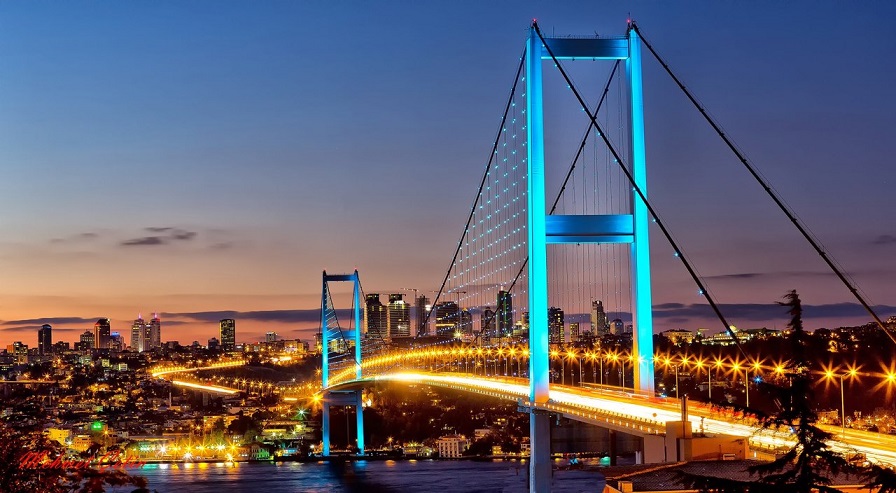In 2007, the tourism ministry of Turkey released an official document that excited the travel industry across the world. Turkey had road mapped an ambitious and extremely detailed plan that they aim to achieve by 2023. Their objective or mission statement is to:
“Become one of the top five visited countries in the world, therefore generating mass tourism revenue.”
As a country that is the meeting point between East and West, it has the perfect strategic position to achieve this plan, but as highlighted, there are many obstacles that need to be overcome, starting with how the world looks at Turkey.

A law was also passed at the turn of the century, allowing foreigners to legally buy property and this in turn, attracted many visitors because prices of property were ridiculously cheap compared with Western countries.
These days, the geographical layout of visitor’s nationalities is quite interesting. Although there are exceptions, the Aegean coast seems popular with British holiday-makers, while Russians and Germans flock to the Mediterranean coast.
The North-East has become popular with Arabic tourists and nationalities like Americans, Australians and Koreans seem to favour the privately guided tours running across the country or independent travel if they are young. Statistics from January 2014, report the top four visiting nationalities as Germans, Bulgarians, Georgians and Russians.

The small town of Belek was thrust into the limelight when it hosted the Turkish Golf Championship that included players like Tiger Woods. Such was his effectiveness at promoting Turkey as a golfing holiday destination; the chairman of the Golfing Federation referred to him as “Gold-Dust” and Turkish Airlines signed him up to a promotional campaign that runs until 2016.
In 2014, the Travellers Choice Destination Award run by TripAdvisor named Istanbul the top destination to visit in the world. Millions of readers took part; therefore generating much hype for city breaks in Istanbul, because the bustling metropolis had managed to push cities like Rome and Paris off their thrones.
Released statistics from the government point to an average of 23 foreign million visitors in 2007, while in 2013, this figure had jumped to 33 million.
The Turkish government has, though, attracted criticism, that their effort to expand tourism is resulting in an environmental disaster. A planned airport for Istanbul, a new all-inclusive hotel near the ancient ruins of Phaselis and plans to rent out part of the old Greek village of Kayakoy on the Mediterranean coast, have all sparked online petitions demanding for these projects to be halted.
Historically though, Turkey has never been a country to back down when the going gets tough. Their plan to market tourism worldwide to all nationalities and increase domestic tourism has probably softened the blow and they are continuing with their mass plan for 2023.

Included are the relatively unknown cities of Macka in the Northeast that is home to the historical Sumela Monastery dating from 386 AD. Kahta is not well known but is at the foot of Nemrut Mountain that is famous for the ancient head statues that are suspected to date from the 1st century BC and adorn most picture postcards Turkey.
The plan states specifically that areas are targeted where a potential for that tourism already exists. So the spa thermal hotels of Izmir benefitted hugely, while eco and plateau tourism for the Kackar Mountains in the Northeast is slowly starting to come popular.
The Antalya region is now known as a hot spot for adventure sports, in particular white water rafting while the Aegean coast is home to the seven churches of revelation, mentioned in the Bible and also including the ancient ruins of Ephesus that now generates millions in income every year.
As well as targeting specific travel genres, they designated several areas for tourism development including Izmir on the Aegean coast, Dalaman on the Mediterranean coast and the relatively small town of Didim that is a popular base for British ex-pats.
There is roughly eight years before the deadline for this ambitious tourism strategy comes into effect. A lot can happen within a country during this time but Turkey has shown tourism is a top priority and by all indications of their previous success, it is likely they will become one of the top five visited countries of the world, if not number one.
Further Reading: The Official Turkish Tourism Strategy

With a higher volume of visitors, rental prospects in already popular areas such as Fethiye, Bodrum, Kalkan, and Antalya are set to see a sharp increase in demand with more tourists looking towards private villa rentals, meaning those who own a home along the Turkish coast can benefit by renting out their property during the peak summer months for a healthy second income stream.
Those who decided to buy property in Yalikavak or purchase a villa in Kalkan are set to see the most significant increase as these are areas where supply is limited, with building restrictions in place, resulting in lots of privacy and lots of demand for tourists looking to escape for luxury holidays. All of this will result in steep-up prices and significant growth on your investment in these regions.
Some resorts that are marketed purely as summer resorts will also see their lives extended due to extended tourism such as golf, sailing, wellness activities, and such. This will result in longer periods of rental income, so higher yields for those who have purchased properties in those areas. You will find superb golfing options in Antalya, and beautiful sailing spots from Bodrum to Fethiye.
Already a huge hub for investment, known as the meeting point between the East and the West, Istanbul is set to become even more so of an investment spot due to the increased popularity of Turkey for travellers, tourists, and business. If you have not already invested in Istanbul, prices are soaring, so the opportunity to do so is today.

“Become one of the top five visited countries in the world, therefore generating mass tourism revenue.”
As a country that is the meeting point between East and West, it has the perfect strategic position to achieve this plan, but as highlighted, there are many obstacles that need to be overcome, starting with how the world looks at Turkey.

History of Tourism in Turkey
Tourism in the country only really took off in the 80s, when Brits started buying all-inclusive holiday packages and the border with Russia opened, prompting regions like Antalya to boom. German visitors also flocked to the country, possibly because of the previous high immigration rates of Turks to Germany in the 1950s.A law was also passed at the turn of the century, allowing foreigners to legally buy property and this in turn, attracted many visitors because prices of property were ridiculously cheap compared with Western countries.
These days, the geographical layout of visitor’s nationalities is quite interesting. Although there are exceptions, the Aegean coast seems popular with British holiday-makers, while Russians and Germans flock to the Mediterranean coast.
The North-East has become popular with Arabic tourists and nationalities like Americans, Australians and Koreans seem to favour the privately guided tours running across the country or independent travel if they are young. Statistics from January 2014, report the top four visiting nationalities as Germans, Bulgarians, Georgians and Russians.

The Last Ten Years
Turkey has already made massive improvement. They embarked on an infrastructure program for the Mediterranean and Aegean coasts which saw a huge improvement in road conditions, and improved Turkey’s status as ideal for self-driving holidays.The small town of Belek was thrust into the limelight when it hosted the Turkish Golf Championship that included players like Tiger Woods. Such was his effectiveness at promoting Turkey as a golfing holiday destination; the chairman of the Golfing Federation referred to him as “Gold-Dust” and Turkish Airlines signed him up to a promotional campaign that runs until 2016.
In 2014, the Travellers Choice Destination Award run by TripAdvisor named Istanbul the top destination to visit in the world. Millions of readers took part; therefore generating much hype for city breaks in Istanbul, because the bustling metropolis had managed to push cities like Rome and Paris off their thrones.
Released statistics from the government point to an average of 23 foreign million visitors in 2007, while in 2013, this figure had jumped to 33 million.
The Turkish government has, though, attracted criticism, that their effort to expand tourism is resulting in an environmental disaster. A planned airport for Istanbul, a new all-inclusive hotel near the ancient ruins of Phaselis and plans to rent out part of the old Greek village of Kayakoy on the Mediterranean coast, have all sparked online petitions demanding for these projects to be halted.
Historically though, Turkey has never been a country to back down when the going gets tough. Their plan to market tourism worldwide to all nationalities and increase domestic tourism has probably softened the blow and they are continuing with their mass plan for 2023.

What Does the Future Hold?
The Turkish tourism strategy was extremely detailed because it targets almost every type of travel genre that exists. Examples include cruise and sea tourism, health and thermal, winter skiing, adventure sports, cultural experiences, religious and faith tourism, business and congress, and ten cities have been targeted as potentials for ideal city-break destinations.Included are the relatively unknown cities of Macka in the Northeast that is home to the historical Sumela Monastery dating from 386 AD. Kahta is not well known but is at the foot of Nemrut Mountain that is famous for the ancient head statues that are suspected to date from the 1st century BC and adorn most picture postcards Turkey.
The plan states specifically that areas are targeted where a potential for that tourism already exists. So the spa thermal hotels of Izmir benefitted hugely, while eco and plateau tourism for the Kackar Mountains in the Northeast is slowly starting to come popular.
The Antalya region is now known as a hot spot for adventure sports, in particular white water rafting while the Aegean coast is home to the seven churches of revelation, mentioned in the Bible and also including the ancient ruins of Ephesus that now generates millions in income every year.
As well as targeting specific travel genres, they designated several areas for tourism development including Izmir on the Aegean coast, Dalaman on the Mediterranean coast and the relatively small town of Didim that is a popular base for British ex-pats.
There is roughly eight years before the deadline for this ambitious tourism strategy comes into effect. A lot can happen within a country during this time but Turkey has shown tourism is a top priority and by all indications of their previous success, it is likely they will become one of the top five visited countries of the world, if not number one.
Further Reading: The Official Turkish Tourism Strategy

What does Turkey´s tourism ambitions mean for its property sector?
Naturally, the elevation of Turkey´s tourism industry will have a direct impact on other industries in Turkey. One said industry set to see the rub-off from the growing tourism in the country, is naturally the Turkish real estate market.With a higher volume of visitors, rental prospects in already popular areas such as Fethiye, Bodrum, Kalkan, and Antalya are set to see a sharp increase in demand with more tourists looking towards private villa rentals, meaning those who own a home along the Turkish coast can benefit by renting out their property during the peak summer months for a healthy second income stream.
Those who decided to buy property in Yalikavak or purchase a villa in Kalkan are set to see the most significant increase as these are areas where supply is limited, with building restrictions in place, resulting in lots of privacy and lots of demand for tourists looking to escape for luxury holidays. All of this will result in steep-up prices and significant growth on your investment in these regions.
Some resorts that are marketed purely as summer resorts will also see their lives extended due to extended tourism such as golf, sailing, wellness activities, and such. This will result in longer periods of rental income, so higher yields for those who have purchased properties in those areas. You will find superb golfing options in Antalya, and beautiful sailing spots from Bodrum to Fethiye.
Already a huge hub for investment, known as the meeting point between the East and the West, Istanbul is set to become even more so of an investment spot due to the increased popularity of Turkey for travellers, tourists, and business. If you have not already invested in Istanbul, prices are soaring, so the opportunity to do so is today.









